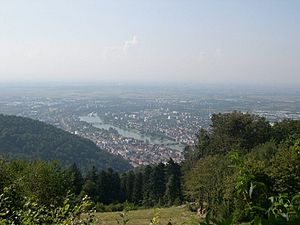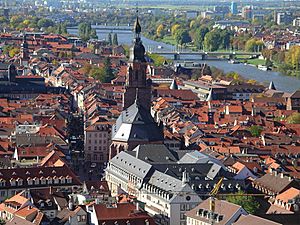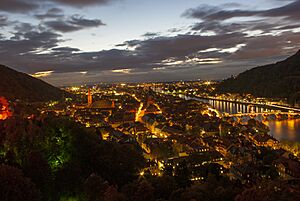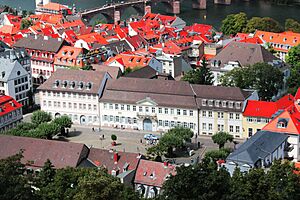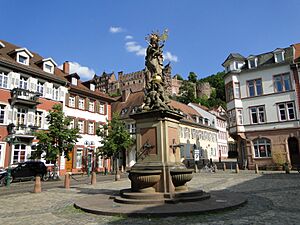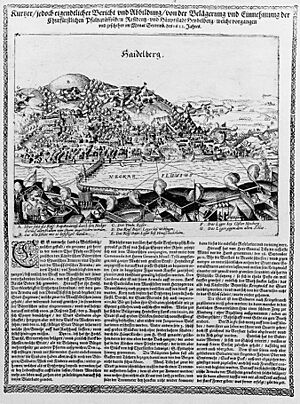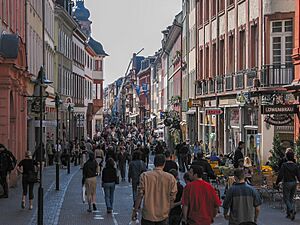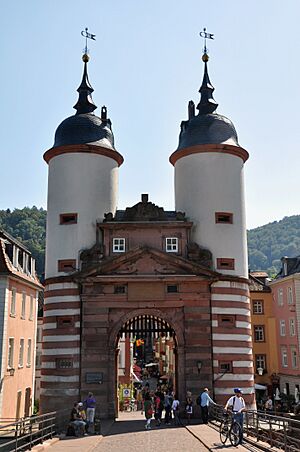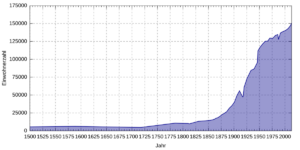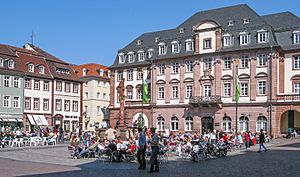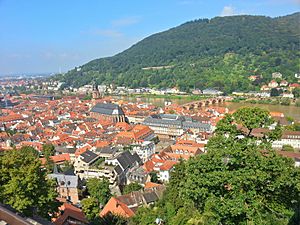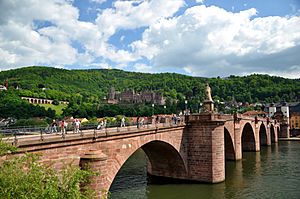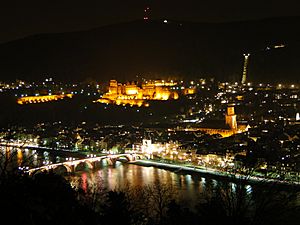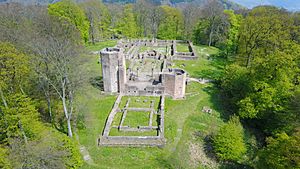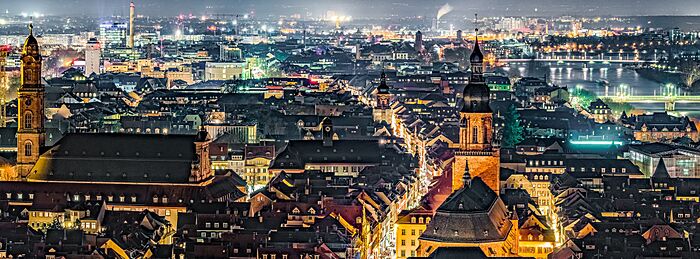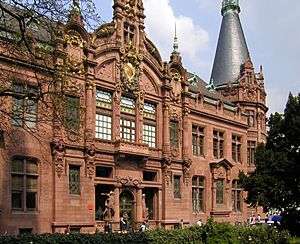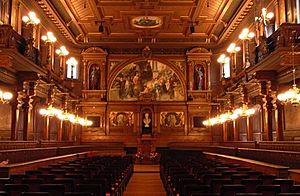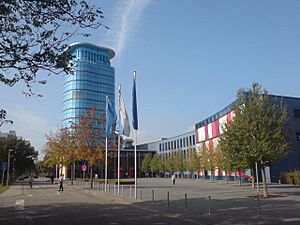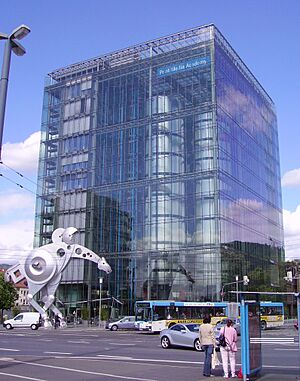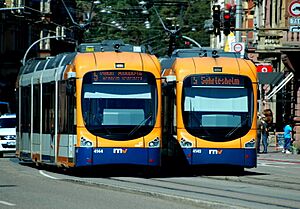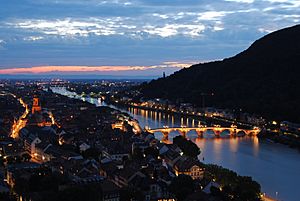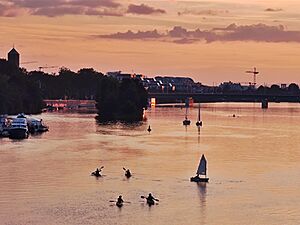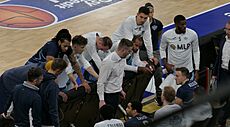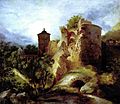Heidelberg facts for kids
Quick facts for kids
Heidelberg
Heidlberg (Palatine German)
|
|||
|---|---|---|---|
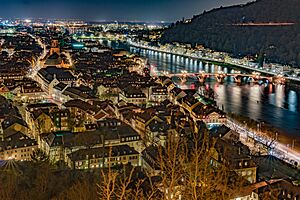
View from Heidelberg Castle park on the city with Heiliggeistkirche and Old Bridge over the Neckar
|
|||
|
|||
| Country | Germany | ||
| State | Baden-Württemberg | ||
| Admin. region | Karlsruhe | ||
| District | Urban district | ||
| Elevation | 114 m (374 ft) | ||
| Population
(2022-12-31)
|
|||
| • Total | 162,273 | ||
| Time zone | CET/CEST (UTC+1/+2) | ||
| Postal codes |
69115–69126
|
||
| Dialling codes | 06221 | ||
| Vehicle registration | HD | ||
Heidelberg is a beautiful city in the German state of Baden-Württemberg. It sits on the Neckar river in southwest Germany. In 2016, about 160,000 people lived here, and a big part of them were students!
Heidelberg is about 78 kilometers (48 miles) south of Frankfurt. It is the fifth-largest city in Baden-Württemberg and part of the busy Rhine-Neckar Metropolitan Region.
Heidelberg University, started in 1386, is Germany's oldest university. It is also one of Europe's most respected schools. Heidelberg is a big center for science in Germany. It has many famous research places near its university. These include the European Molecular Biology Laboratory and four Max Planck Institutes. The city has also been important for arts and literature for a long time. UNESCO even named it a "City of Literature".
Heidelberg used to be the capital of the Electorate of the Palatinate. Today, it is a popular place for tourists. People love its romantic look, with Heidelberg Castle, the Philosophers' Walk, and the old Baroque town.
Contents
- Exploring Heidelberg's Location
- Heidelberg's Past: A Journey Through Time
- Heidelberg's Growing Population
- Exploring Heidelberg's Cityscape
- Learning and Discovery in Heidelberg
- Heidelberg's Economy and Transport
- Heidelberg's Culture and Fun
- Sports in Heidelberg
- Heidelberg's Twin Cities and Friends
- Famous People from Heidelberg
- Images for kids
- See also
Exploring Heidelberg's Location
Heidelberg is on the eastern edge of the Upper Rhine Plain. This is where the Neckar river leaves its narrow valley. The valley runs through the Odenwald mountains. From here, the Neckar flows across the plain to Mannheim, about 20 kilometers (12 miles) away, where it joins the Rhine.
A part of Heidelberg, including the old town and Heidelberg Castle, is in the narrow Neckar valley. Other parts of the city spread out into the Rhine Plain. They also go along the Bergstraße, which means "mountain road." This is a narrow strip of land between the plain and the Odenwald mountains.
The city is surrounded by three mountains: the Königstuhl (568 m or 1,864 ft), the Gaisberg (375 m or 1,230 ft), and the Heiligenberg (445 m or 1,460 ft).
Heidelberg is also on the European walking route E1, which goes from Sweden to Umbria in Italy.
Unique Plants and Animals in Heidelberg
Heidelberg is one of the warmest places in Germany. Because of this, plants that usually do not grow in Central Europe thrive here. You can find almond and fig trees. There are also many kinds of palm trees and olive trees. Along the Philosophenweg (Philosophers' Walk), people started growing wine again in 2000.
You might also see some interesting animals. There is a wild group of African rose-ringed parakeets. Also, a wild group of Siberian swan geese lives here. You can often spot them on the islands in the Neckar river, near the Bergheim area.
How Heidelberg is Organized
Heidelberg is a special type of city government called a unitary authority. It is part of the Regierungsbezirk Karlsruhe. The Rhein-Neckar-Kreis rural district surrounds it, but Heidelberg is not part of that district. Heidelberg is part of the larger Rhine-Neckar Metropolitan Region. This area is often called the Rhein-Neckar Triangle.
This region includes parts of Hessen, Rhineland-Palatinate, and the areas around Mannheim and Heidelberg. It became a European metropolitan area in 2005.
Heidelberg has 15 districts, divided into six main areas. The central area has Altstadt (the Old Town), Bergheim, and Weststadt. To the north are Neuenheim and Handschuhsheim. In the east, you will find Ziegelhausen and Schlierbach. The south has Südstadt, Rohrbach, Emmertsgrund, and Boxberg. In the southwest is Kirchheim. The west includes Pfaffengrund, Wieblingen, and a new district called Bahnstadt. This new area is being built for about 5,000–6,000 residents and 7,000 jobs. Also, a large area called Patrick Henry Village is now open for new homes.
Neighboring Towns and Villages
Heidelberg is bordered by several towns and villages. Starting from the west and going clockwise, they are: Edingen-Neckarhausen, Dossenheim, Schriesheim, Wilhelmsfeld, Schönau, Neckargemünd, Bammental, Gaiberg, Leimen, Sandhausen, Oftersheim, Plankstadt, Eppelheim (all in the Rhein-Neckar-Kreis), and Mannheim.
Heidelberg's Climate and Weather
Heidelberg has an oceanic climate. This means it has mild temperatures all year. The city is in a protected valley between the Pfälzerwald and the Odenwald mountains. Warm air from the Atlantic Ocean usually keeps winters mild. In summer, air from the western Mediterranean Sea brings warmth.
Unlike the nearby Upper Rhine Plain, Heidelberg's valley location often brings more easterly winds. The hills of the Odenwald also cause more clouds and rain.
Spring usually starts early, around mid-February. The weather in spring is warm but can change quickly.
Summer typically lasts from June to September. The weather is usually stable, with only occasional thunderstorms. Daytime temperatures are often around 30 °C (86 °F), but can reach up to 40 °C (104 °F) during heat waves.
Autumn starts warm in September and cools down by late November. It rains more often, and fog becomes common from mid-October.
Winters are mostly mild. Light frosts can happen at night in the coldest months. Snow is rare, and rain is the usual type of precipitation. Winters are the wettest time of the year. Strong storms can cause damage, and the Neckar river often floods.
In 2009, the German Meteorological Service said Heidelberg was the warmest place in Germany.
| Climate data for Heidelberg (1991-2020) | |||||||||||||
|---|---|---|---|---|---|---|---|---|---|---|---|---|---|
| Month | Jan | Feb | Mar | Apr | May | Jun | Jul | Aug | Sep | Oct | Nov | Dec | Year |
| Daily mean °C (°F) | 2.8 (37.0) |
3.8 (38.8) |
7.4 (45.3) |
11.6 (52.9) |
15.6 (60.1) |
18.8 (65.8) |
20.8 (69.4) |
20.4 (68.7) |
16.0 (60.8) |
11.3 (52.3) |
6.6 (43.9) |
3.6 (38.5) |
11.6 (52.8) |
| Average precipitation mm (inches) | 47.9 (1.89) |
45.3 (1.78) |
49.4 (1.94) |
42.7 (1.68) |
70.3 (2.77) |
65.1 (2.56) |
73.2 (2.88) |
64.0 (2.52) |
55.8 (2.20) |
59.5 (2.34) |
60.5 (2.38) |
63.2 (2.49) |
696.9 (27.43) |
| Mean monthly sunshine hours | 48.4 | 77.7 | 133.2 | 190.3 | 214 | 226.7 | 239.5 | 226.2 | 166.5 | 103.4 | 50.6 | 37.7 | 1,714.1 |
| Source: Deutscher Wetterdienst | |||||||||||||
Heidelberg's Past: A Journey Through Time
Ancient Times in Heidelberg
A very long time ago, between 600,000 and 200,000 years ago, an early human called "Heidelberg Man" lived near Mauer. His jaw bone was found in 1907. Scientists say it is the oldest proof of human life in Europe. Around 500 BC, Celtic people built a fort and a place of worship on the Heiligenberg, or "Holy Mountain." You can still see parts of these places today.
In 40 AD, the Romans built a fort here. They also built a wooden bridge over the Neckar river. This camp protected the first small towns. Later, Germanic tribes took over the area.
Heidelberg in the Middle Ages
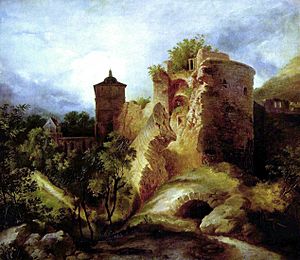
Modern Heidelberg started around the 5th century. A village called Bergheim (Mountain Home) was first mentioned in 769 AD. This village is now in the middle of Heidelberg. People slowly became Christians. In 870 AD, the monastery of St. Michael was built on the Heiligenberg. Around 1130, another monastery, Neuburg, was founded in the Neckar valley.
The first time Heidelberg was mentioned in writing was in 1196. This is seen as the city's founding date. In 1156, Heidelberg Castle and its nearby town were taken over by the House of Hohenstaufen. In 1386, Rupert I, Elector Palatine founded Heidelberg University.
Heidelberg's Modern History
Heidelberg University was very important in the Middle Ages. It played a big part in the German Reformation. In 1518, Martin Luther visited Heidelberg to talk about his ideas.
Heidelberg's library, started in 1421, is the oldest public library still open in Germany.
In 1537, the castle higher up the mountain was destroyed by a gunpowder explosion. A new palace was built where the lower castle stood.
During the Thirty Years' War, in 1622, armies captured Heidelberg. The famous Bibliotheca Palatina library from the Church of the Holy Spirit was given to the Pope.
Later, in 1689 and 1693, French troops attacked Heidelberg. They caused a lot of damage to the town and castle. Because of these wars and very cold winters, many German Protestants left the area in the early 1700s. Some went to London, and others traveled to America, settling in places like New York and Pennsylvania.
In 1720, the ruler, Karl III Philip, Elector Palatine, moved his court to Mannheim. This happened because of religious disagreements with the mostly Protestant people of Heidelberg.
Heidelberg from 1803 to 1933
In 1803, Heidelberg became part of the Grand Duchy of Baden. Charles Frederick, Grand Duke of Baden, reopened the university. It was named "Ruperto-Carola" after its two founders. Many smart people came to teach and study there. In the 18th century, the town was rebuilt in the Baroque style, keeping its old medieval layout.
In 1815, leaders from Austria, Russia, and Prussia formed the "Holy Alliance" in Heidelberg. In 1848, the German National Assembly met here.
Heidelberg During World War II
During the Nazi period (1933–1945), the Nazi party was very strong in Heidelberg. In 1938, during Kristallnacht, Nazis burned down synagogues in the city. Soon after, they began sending Jewish people to concentration camps. Many died from hunger and disease.
Heidelberg was lucky during World War II. Unlike most German cities, it was not bombed by the Allies. One reason is that it was not a big industrial or transport center. Another reason is that American forces wanted to use the city after the war. On March 29, 1945, German troops left the city. They destroyed parts of the old bridge. The U.S. Army entered Heidelberg on March 30, 1945, and the city surrendered peacefully.
Heidelberg After 1945
In 1945, Heidelberg University reopened quickly. This was thanks to a few professors who were against the Nazis.
After the war, the U.S. Army used Heidelberg as its headquarters in Europe. Many American soldiers and their families lived here. The U.S. Army left Heidelberg in 2012 and 2013. By 2015, all American forces had moved out. The old military areas are now being used for civilian purposes.
Heidelberg's Growing Population
Heidelberg's population went over 100,000 for the first time in 1946. It is a city with people from all over the world. It used to have one of the largest American communities outside North America.
At the end of 2011, the city had almost 150,000 residents. This number did not include the U.S. Army soldiers and their families. Today, Heidelberg has about 160,000 people. It is the 5th largest city in Baden-Württemberg. About 37,000 people (24% of the population) are students. This makes Heidelberg one of Germany's biggest university cities. Heidelberg's population has grown steadily since 1945. Many workers, students, and business people have moved here because it is a popular city.
| Rank | Nationality | Population (31 December 2022) |
|---|---|---|
| 1 | 2,921 | |
| 2 | 1,670 | |
| 3 | 1,538 | |
| 4 | 1,453 | |
| 5 | 1,283 | |
| 6 | 1,135 | |
| 7 | 1,067 | |
| 8 | 972 | |
| 9 | 915 | |
| 10 | 864 |
Exploring Heidelberg's Cityscape
The Charming Old Town
Religion in Heidelberg (2011) Protestant Church (34.9%) Catholic Church (30.1%) Orthodox Christianity (1.7%) Evang. Free Church (1.2%) Other state-recognised church/religious community (3.2%) Islam (5.7%) Others or nonreligious (23.2%)
The "old town" (German: Altstadt) is long and narrow, located on the south bank of the Neckar river. It is overlooked by the ruins of Heidelberg Castle. The castle sits 80 meters (260 feet) above the Neckar on the steep, wooded slopes of the Königstuhl (King's chair or throne) hill.
Here are some highlights of the old town:
- The Main Street (Hauptstrasse) is a mile-long street just for walking. It runs through the whole old town.
- The old stone bridge was built from 1786 to 1788. A medieval bridge gate is on the old town side. It was once part of the town wall.
- The Church of the Holy Spirit (Heiliggeistkirche) is a beautiful old church in the marketplace.
- The Karls' gate (Karlstor) is a grand arch built to honor Prince Elector Karl Theodor. It was built from 1775 to 1781.
- The house Zum Ritter Sankt Georg (Knight St. George) is one of the few buildings that survived the wars. It is across from the Church of the Holy Spirit and was built in the late Renaissance style.
- The Marstall (Stables) is a 16th-century building by the Neckar river. It has been used for many things over time. Now, it is a cafeteria for the university.
Heidelberg Castle: A Historic Landmark
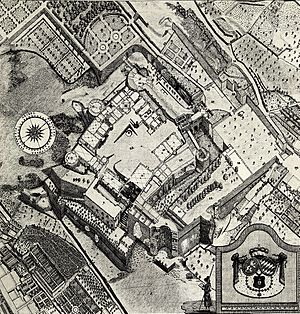
The castle is a mix of different building styles, from Gothic to Renaissance. Prince Elector Ruprecht III (1398–1410) built the first royal residence in the inner courtyard. Later, in the 16th and 17th centuries, other rulers added more palace buildings. They turned the fortress into a grand castle.
The castle and its garden were damaged many times during wars. In 1764, lightning struck, and rebuilding stopped. Later, people even took stones from the castle to build new houses in Heidelberg. This stopped in 1800, thanks to Count Charles de Graimberg, who started to protect the castle.
Today, the King's Hall in the castle is used for parties, dinners, and theater shows. During the Heidelberg Castle Festival in summer, you can enjoy outdoor musicals, operas, and concerts.
The castle is surrounded by a park. The famous poet Johann von Goethe used to walk here. A funicular railway, the Heidelberger Bergbahn, goes from Kornmarkt to the top of the Königstuhl mountain, passing by the castle.
From the castle, you can see amazing views of all of Heidelberg and the Neckar Valley.
Philosophers' Walk: A Scenic Path
On the northern side of the Neckar river is the Heiligenberg (Saints' Mountain). Along its side runs the Philosophers' Walk (German: Philosophenweg). This path offers beautiful views of the old town and the castle. In the past, Heidelberg's philosophers and university professors would walk and talk along this path.
Higher up the mountain, you can find the ruins of the 11th-century Monastery of St. Michael. There is also a smaller Monastery of St. Stephen, a Nazi-era amphitheater, and the remains of an ancient Celtic hill fort from the 4th century BC.

Heidelberg's Churches: Places of Worship and History
Heidelberg has many old and historic churches. The Church of the Holy Spirit has been used by both Catholics and Protestants for centuries. It is one of the few buildings that survived the many wars. It was rebuilt after being set on fire by the French in 1709. The church holds remains of tombs and memorials of past rulers. This church stands in the Marktplatz (marketplace) next to the town hall.
In 1720, there was a disagreement when the ruler gave the Church of the Holy Spirit only to Catholics. It had been split by a wall and used by both groups. Because of pressure from other countries, the church was split again for joint use. In 1936, the separating wall was removed. Now, the church is used only by Protestants.
There is also the Catholic Church of the Jesuits. Its building started in 1712. It was finished with a bell tower added from 1866 to 1872. This church also has a museum of religious art. The oldest church in Heidelberg is St. Peter's Church (now Lutheran). It was built around the 12th century.
Learning and Discovery in Heidelberg
Universities and Colleges in Heidelberg
Heidelberg is famous for its schools and universities. The most well-known is Heidelberg University. It was founded in 1386, making it one of Europe's oldest universities. In fact, Heidelberg is the oldest university town in Germany today. Many famous thinkers have been connected to this university.
The university has different campuses. The Faculties of Humanities, Social Science, and Law are in historical buildings in the old town. The school of applied sciences is in the Science Tower in Wieblingen. The Faculties of Medicine and Natural Science are on the Neuenheimer Feld Campus.
Heidelberg University had 30,898 undergraduate students in 2014. About 16% of students who apply get in. Less than 20% of the students are from other countries. The university does not charge tuition fees. Most classes are taught in German. For international students, the academic year is based on 5-week blocks.
Since 1904, there has been a College of Educational Science, the Pädagogische Hochschule Heidelberg. Since 1979, there has been a college of Jewish Studies, the Hochschule für Jüdische Studien Heidelberg. It has nine areas of study focusing on religion and Jewish culture. Schiller International University, a private American university, also has a campus in Heidelberg. It offers programs in International Business and International Relations.
Research and Innovation in Heidelberg
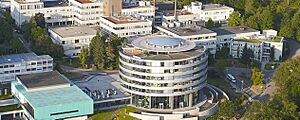
Besides the university's research centers, Heidelberg has many other research places. These include the European Molecular Biology Laboratory (EMBL), the European Molecular Biology Organization (EMBO), and the German Cancer Research Center (DKFZ). There are also several Max Planck Institutes here. These are the Max Planck Institute for Medical Research, Max Planck Institute for Astronomy, Max Planck Institute for Nuclear Physics, and Max Planck Institute for Comparative Public Law and International Law.
Schools for Young Learners in Heidelberg
Heidelberg has 23 elementary schools. There are also many secondary schools, both public and private. These schools cover all levels of the German school system. There are 14 Gymnasiums, which are schools that prepare students for university. Six of these are private. About 52% of secondary students in Heidelberg go to a Gymnasium. This is higher than the German average, perhaps because many academics live in Heidelberg.
Some of the Gymnasiums include the Kurfürst-Friedrich-Gymnasium, Bunsen-Gymnasium, Helmholtz-Gymnasium, Hölderlin-Gymnasium, and Elisabeth-von-Thadden-Schule. There are also seven Realschules, ten Hauptschules, and nine vocational schools (Berufsschule). Additionally, there are several adult education centers with different specialties. Heidelberg International School serves children of families from other countries.
Heidelberg's Economy and Transport
Tourism: A Key Industry
In 2004, over 80% of people in Heidelberg worked in service industries, including tourism. Heidelberg is known as a "Romantic town." This helps attract more than 11.9 million visitors every year. Many events are held to bring in tourists. One of the biggest attractions is the Christmas market in winter.
Local Industries and Businesses
Only about 18% of jobs in Heidelberg are in industry. Printing and publishing are important businesses here. Nearby Walldorf is a center for the IT industry and home to SAP World Headquarters. The well-known pen maker Lamy has its main office and factory in Heidelberg-Wieblingen. Heidelberger Druckmaschinen, a printing machine company, has its headquarters here. The soft-drink company Wild-Werke, which makes Capri-Sonne (Capri-Sun), is nearby in Eppelheim. Heidelberg is also home to HeidelbergCement, one of the world's largest cement producers. The company started in the suburb of Leimen, where one of its cement plants still operates. With its long Hauptstraße, Heidelberg is a popular shopping spot for people from smaller towns around it.
Roads Connecting Heidelberg
The A 5 autobahn runs along the western edge of Heidelberg. It connects the area to Frankfurt am Main in the north and Karlsruhe to the south. The A 656 starts just west of the city, linking Heidelberg with Mannheim. These two highways meet at the Heidelberg autobahn intersection. The A 656 also connects to the A 6 at the Mannheim intersection, which goes east towards Stuttgart.
Also, the B 3 (Frankfurt–Karlsruhe) runs north–south through the town. The B 37 (Mannheim–Eberbach) runs east–west. Both meet in the city center at Bismarckplatz. The B 535 starts south of Heidelberg and goes to Schwetzingen.
Scenic Tourist Roads
Heidelberg is located on four special tourist roads: Bergstraße, Bertha Benz Memorial Route, Castle Road, and Straße der Demokratie (Road of Democracy).
Railways and Train Travel
Heidelberg Central Station (Hauptbahnhof) is on the Rhine Valley Railway. It is served by fast Intercity-Express and Euro City trains. This station is also part of the RheinNeckar S-Bahn network. There is also a station for intercity bus services outside the central station.
Public Transportation in Heidelberg
The main transport center in Heidelberg is Bismarckplatz. Many main roads meet here. One of Europe's longest pedestrian streets, the Hauptstraße (main street), starts here and goes through the entire old town. Heidelberg Central Station was moved in 1955 to the west. This made it easier for trains to pass through without having to turn around. The new central station became another major transport hub.
Heidelberg has had public transport since 1883, with horse-drawn trams. In 1902, the tram network became electric. Over time, parts of the tram network were removed as cars became more popular. However, in 2006, a new tram line was opened. Tram and bus services are now run by Rhein-Neckar-Verkehr (RNV). Since 1989, all tickets are part of a single system by the Verkehrsverbund Rhein-Neckar (Rhine-Neckar Transport Association, VRN). Carsharing is also growing, with over 50 car-sharing stations in Heidelberg.
Since 2003, Heidelberg has been connected to the Rhine-Neckar S-Bahn network. This train system connects the entire Rhine-Neckar region.
The Heidelberger Bergbahn (Heidelberg Mountain Railway) is a funicular railway. It runs from Kornmarkt to Molkenkur with new cars. From Molkenkur to Königstuhl, it uses historic cars built in 1907. It is a very popular way to reach Heidelberg Castle.
Heidelberg's Culture and Fun
Festivals and Events in Heidelberg
Heidelberg hosts many festivals and events throughout the year. In February, there is the Ball der Vampire (Ball of the Vampires). This is a big vampire-themed costume party at the castle or city hall during Fasching. In March or April, you can enjoy the Heidelberger Frühling, a Classic Music Festival, and an international Easter egg market. There is also a half marathon every year in late April.
In summer, there is the Frühlingsmesse (Spring Fair) and beautiful illuminations of the castle and bridge with lights and fireworks. In September, the Old Town Autumn Festival takes place. It has a Medieval Market, an arts and crafts market, a flea market, and music. In October or November, there are the Heidelberger Theater Days and the Enjoy Jazz festival. The International Filmfestival Mannheim-Heidelberg also happens here every November. It shows art films from new directors. During Christmas, there is a Christmas market in the oldest part of the city. A famous local treat is the chocolate called Heidelberger Studentenkuss (student kiss).
Cinemas in Heidelberg
Heidelberg has seen some changes in its cinemas. For a while, there were only three small cinemas. But since late 2017, a new large cinema, the "Luxor Filmpalast," opened near the new Bahnstadt area.
Luxor mainly shows big Blockbuster movies in German. However, they also have some showings in English.
The smaller 2-screen cinema "Gloria/Gloriette" in the Old Town, and its partner "Kamera" in Neuenheim, show art films and independent movies. Many of these are shown in their original language with German subtitles.
The non-profit "Karlstorkino" (at the eastern edge of the Old Town) shows international art films and documentaries. Most non-German films here are shown in their original language with English or German subtitles.
Museums and Exhibitions to Explore
Heidelberg has many interesting museums. The Carl Bosch Museum shows the life and work of chemist and Nobel Prize-winner Carl Bosch. The Documentation and Culture Centre of German Sinti and Roma tells the story of the Nazi genocide of the Sinti and Roma peoples.
The German Packing Museum (Deutsches Verpackungsmuseum) shows the history of packaging. The German Pharmacy Museum (Deutsches Apothekenmuseum), located in the castle, explains the history of pharmacy in Germany. The Kurpfälzisches Museum (Palatinate Museum) has a great art collection and Roman artifacts from the area. The President Friedrich Ebert Memorial honors Friedrich Ebert, Germany's first democratic head of state. You can also take guided tours of most historical places in Heidelberg.
Heidelberg's Romantic Side

Heidelberg was a major center for the Romanticism movement in Germany. This period is often called Heidelberg Romanticism. There was a famous group of poets here, including Joseph von Eichendorff, Johann Joseph von Görres, Ludwig Achim von Arnim, and Clemens Brentano. The Philosophers' Walk (German: Philosophenweg) is a reminder of this romantic era.
Romanticism was a movement that went against strict, realistic ideas in art and literature. It celebrated medieval times, folk art, and nature. It also focused on how human activities like language and customs are shaped by nature.
"Old Heidelberg" and Famous Songs
In 1901, Wilhelm Meyer-Förster wrote a play called Old Heidelberg. This play was later made into many films. It also inspired the 1924 operetta The Student Prince, which became a film.
The 1925 song "I Lost My Heart in Heidelberg" by Fred Raymond was a huge hit. It led to a stage musical and two films. This song is still the theme song of Heidelberg today.
Sports in Heidelberg
Heidelberg is one of the main places for Rugby union in Germany, along with Hanover. In 2008–09, four of the nine clubs in the Rugby-Bundesliga were from Heidelberg. These were RG Heidelberg, SC Neuenheim, Heidelberger RK, and TSV Handschuhsheim. Heidelberger TV also has a rugby team.
Rugby League Deutschland has two teams in Heidelberg: Heidelberg Sharks (started in 2005) and Rohrbach Hornets (started in 2007).
The city is also home to the USC Heidelberg (Academics Heidelberg) basketball team. They have won 9 German Basketball Championships, making them the second most successful team in German professional basketball history. Today, the club plays in Germany's second division, ProA. It is well-known for its youth program, which has helped many players join Germany's senior national basketball team.
SG Heidelberg-Kirchheim is the local football (soccer) team.
Heidelberg hosted the 1972 Summer Paralympics. They also hosted the 2019 WU24 Championships for ultimate frisbee.
Germany's oldest tennis club, founded in 1890, is located in Heidelberg.
Heidelberg's Twin Cities and Friends
Heidelberg has special partnerships with these cities:
 Montpellier, France (1961)
Montpellier, France (1961) Cambridge, United Kingdom (1965)
Cambridge, United Kingdom (1965) Rehovot, Israel (1983)
Rehovot, Israel (1983) Bautzen, Germany (1991)
Bautzen, Germany (1991) Simferopol, Ukraine (1991)
Simferopol, Ukraine (1991) Kumamoto, Japan (1992)
Kumamoto, Japan (1992) Palo Alto, United States (2017)
Palo Alto, United States (2017) Hangzhou, China (2017)
Hangzhou, China (2017)
Friendly Cities
Heidelberg also has friendly relations with:
 Calamba, Philippines
Calamba, Philippines Heidelberg, South Africa
Heidelberg, South Africa Jelenia Góra, Poland
Jelenia Góra, Poland Mostar, Bosnia and Herzegovina
Mostar, Bosnia and Herzegovina
Famous People from Heidelberg
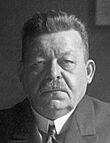
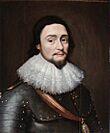

Many notable people have connections to Heidelberg:
- Carl Bosch (1874–1940), a chemist and engineer who won the Nobel Prize.
- Jackson Browne (born 1948), a singer-songwriter born here.
- Robert Bunsen (1811–1899), a German chemist.
- Friedrich Ebert (1871–1925), the first President of Germany.
- Michael Fassbender (born 1977), a German-Irish actor born here.
- Hansi Flick (born 1965), a football player and manager of the Germany national football team.
- Frederick V (1596–1632), a ruler of the Palatinate and King of Bohemia.
- Harald zur Hausen (1936–2023), a virologist and Nobel laureate.
- Dietmar Hopp (born 1940), a software entrepreneur who co-founded SAP.
- Muhammad Iqbal (1877–1938), a poet and philosopher from British India.
- Wolfgang Ketterle (born 1957), a physicist and Nobel Laureate.
- Ananda Mahidol (1925–1946), a King of Thailand.
- Malaika Mihambo (born 1994), an Olympic champion in long jump.
- Nelson Piquet Jr. (born 1985), a Brazilian race car driver born here.
- José Rizal (1861–1896), the national hero of the Philippines.
- Khalid Robinson (born 1998), an American singer.
- Silvia Renate Sommerlath (born 1943), who became the Queen of Sweden.
- Albert Speer (1905–1981), a German architect and minister during the Third Reich.
- Ashley Wagner (born 1991), an American figure skater.
Images for kids
-
Heidelberg Castle, shown here in a painting, was damaged during a war.
-
Romantic view of Heidelberg Castle ruins by Karl Philipp Fohr, 1815
See also
 In Spanish: Heidelberg para niños
In Spanish: Heidelberg para niños





